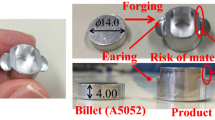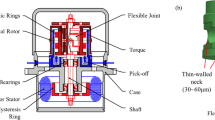Abstract
To improve the neck-spinning processing quality of plunger components, a reliable finite element (FE) model was established and validated by the experimental spinning force. In the advanced FE model, an additional analysis step was added to obtain the pulling-out force, the axial clearance, and the swing angle of the plunger components after the neck-spinning process. Thus, the neck-spinning quality of the plunger components can be predicted. The results show that the simulated results using the FE model agree with the experimental results very well. The radial and axial spinning forces are approximate 3 and 2 times of the tangential spinning force, respectively. Finally, the influences of spinning parameters (e.g., feed rate and rotating speed) on the finished pulling-out force, axial clearance, and swing angle were evaluated in detail. The pulling-out force increases with increased feed rate, which tends to be stable with increased rotating speed. Compared with the stable tendency of axial clearance affected by feed rates, the axial clearance decreases significantly with increased rotating speeds. The swing angle of plunger components remains stable with different feed rate and rotating speed after the neck-spinning process.



















Similar content being viewed by others
References
Xu B, Zhang JH, Yang HY (2012) Investigation on structural optimization of anti-overturning slipper of axial piston pump. Sci China Technol Sci 55(11):3010–3018
Noah DM, Chris LW, Dong ZL (2004) Experimental studies on the performance of slipper bearings within axial-piston pumps. J Tribol 126:511–518
Doikina A, Zadeh EH, Campean F, Priest M, Brown A, Sherratt A (2018) Impact of duty cycle on wear progression in variable-displacement vane oil pumps. Procedia Manuf 16:115–122
Posch S, Hopfgartner J, Berger E, Zuber B, Schöllauf P, Almbauer R (2018) Numerical analysis of a hermetic reciprocating compressor oil pump system. Int J Refrig 85:135–143
Zhang JH, Chao Q, Wang QN, Xu B, Chen Y, Li Y (2017) Experimental investigations of the slipper spin in an axial piston pump. Meas 102:112–120
Koc E, Hooke CJ, Li KY (1992) Slipper balance in axial piston pumps and motors. J Tribol 114:766–772
Music O, Allwood JM, Kawai K (2010) A review of the mechanics of metal spinning. J Mater Process Technol 210:3–23
Thanapat S, Surangsee D (2017) Spinning process design using finite element analysis and taguchi method. Procedia Eng 207:1713–1718
Wu H, Xu Shan WD, Jin BC (2019) An extended GTN model for low stress triaxiality and application in spinning forming. J Mater Process Technol 263:112–128
Xia Q, Xiao G, Long H, Sheng X (2014) A review of process advancement of novel metal spinning. International Int J Mach Tool Manu 85:100–121
Yin C, Dai W, Lian YN (2016) Optimization of the manufacturing defects of plunger unit based on ion implantation. Procedia CIRP 56:46–49
Huang L, Yang H, Zhan M (2008) 3D-FE modeling method of splitting spinning. Comput Mater Sci 42:643–652
Huang L, Yang H, Zhan M, Hu LJ (2009) Forming characteristics of splitting spinning based on the behaviors of roller. Comput Mater Sci 45:449–461
Wang L, Long H (2011) Investigation of material deformation in multi-pass conventional metal spinning. Mater Des 32:2891–2899
Xia QX, Lai ZY, Long H, Cheng XQ (2013) A study of the spinning force of hollow parts with triangular cross sections. Int J Adv Manuf Technol 68(9–12):2461–2470
Xia QX, Cheng XQ, Long H, Ruan F (2012) Finite element analysis and experimental investigation on deformation mechanism of non-axisymmetric tube spinning. Int J Adv Manuf Technol 59:263–272
Dai W, Lian YN, Xiao JL, Luo G (2016) Analysis and optimization of plunger necking-in process based on finite element simulation. First International Conference on Reliability Systems Engineering, IEEE
Huang CC, Hung JC, Hung C (2011) Finite element analysis on neck-spinning process of tube at elevated temperature. Int J Adv Manuf Technol 56:1039–1048
Guo YM, Li MZ, Xu HQ, Li LL, Wang LY, Luo W, Zheng HW, Gao WL (2018) Research on multi-pass hot spinning based on finite element simulation and experiment for aluminum alloy component. Int J Adv Manuf Technol 97:1995–2008
Zoghi H, Fallahi AA (2013) Finite element study of stress and strain state during hot tube necking process. J Eng Manuf 227(4):551–564
Wang L, Long H, Ashley D, Roberts M, White P (2011) Effects of the roller feed ratio on wrinkling failure in conventional spinning of a cylindrical cup. Proc Inst Mech Eng, Part B 225(11):1991–2006
Xia QX, Cheng XQ, Hu Y, Ruan F (2006) Finite element simulation and experimental investigation on the forming forces of 3D non-axisymmetrical tubes spinning. Int J Mech Sci 48:726–735
Bai Q, He Y, Mei Z (2008) Finite element modeling of power spinning of thin-walled shell with hoop inner rib. Trans Nonferrous Met Soc China 18(1):6–13
Jia Z, Han ZR, Xu Q, Peng WF (2014) Numerical simulation and experiment study on hollow spinning process for square cross-section cone. Int J Adv Manuf Technol 75(9–12):1605–1612
Xu W, Zhao X, Ma H, Shan D, Lin H (2016) Influence of roller distribution modes on spinning force during tube spinning. Int J Mech Sci 113:10–25
Zhang JH, Zhan M, Yang H, Jiang ZQ, Han D (2012) 3D-FE modeling for power spinning of large ellipsoidal heads with variable thicknesses. Comput Mater Sci 53:303–313
Yang H, Huang L, Zhan M (2010) Coupled thermo-mechanical FE simulation of the hot splitting spinning process of magnesium alloy AZ31. Comput Mater Sci 47:857–866
Selvan JS, Subramanian K, Nath AK (1999) Effect of laser surface hardening on En18 (AISI 5135) steel. J Mater Process Technol 91:29–36
Gao ZR (2003) Commonly used steel selection manual Taiyuan: Shanxi Science and Technology Press: 24 (In Chinese)
Funding
The authors gratefully acknowledge the financial supports of the National Science and Technology Major Project of “high-grade CNC machine tools and basic manufacturing equipment” (No. 2017ZX04008008-004-011) and Nanjing University of Aeronautics and Astronautics Ph. D. short-term visiting scholar project (No. 190304DF06).
Author information
Authors and Affiliations
Corresponding author
Additional information
Publisher’s note
Springer Nature remains neutral with regard to jurisdictional claims in published maps and institutional affiliations.
Rights and permissions
About this article
Cite this article
Wang, Y., Su, H., Lu, G. et al. Quality prediction of plunger components based on the finite element method during the neck-spinning process. Int J Adv Manuf Technol 106, 1509–1520 (2020). https://doi.org/10.1007/s00170-019-04735-6
Received:
Accepted:
Published:
Issue Date:
DOI: https://doi.org/10.1007/s00170-019-04735-6




